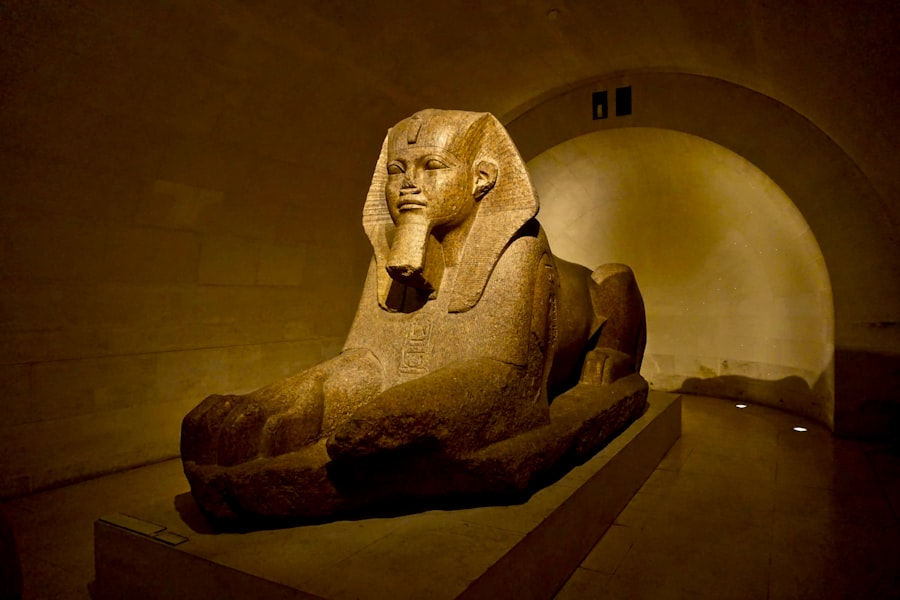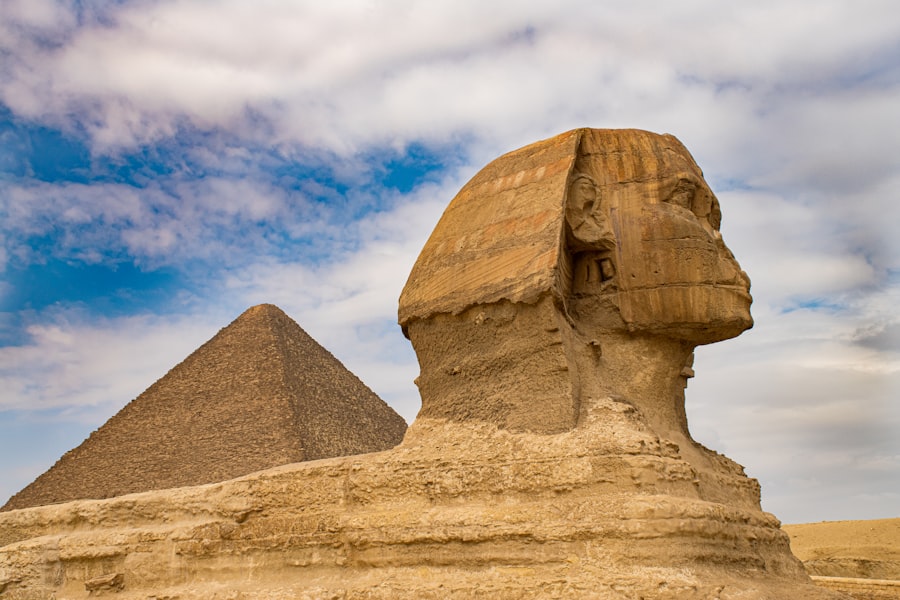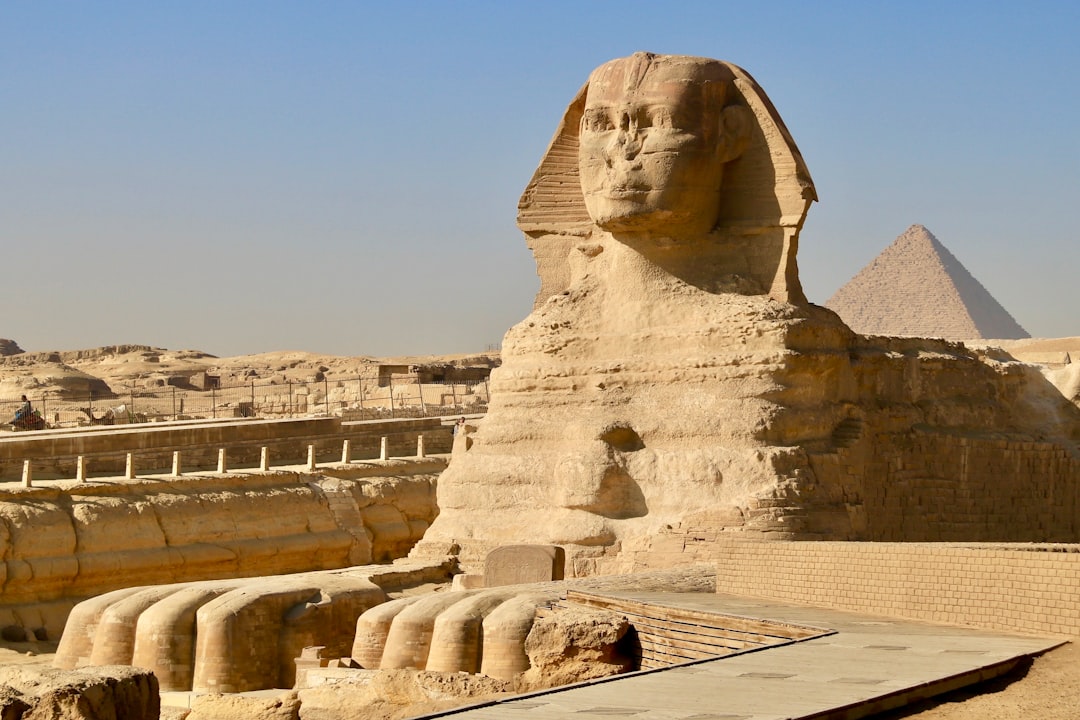The Great Sphinx of Giza stands as one of the most iconic monuments of ancient Egypt, captivating the imagination of historians, archaeologists, and tourists alike. This colossal limestone statue, with the body of a lion and the head of a human, is situated on the Giza Plateau, adjacent to the Pyramids of Giza. Its grandeur and enigmatic presence have made it a symbol of ancient Egyptian civilization and a testament to the architectural prowess of its creators.
The Sphinx has endured the ravages of time, weathering millennia of natural erosion and human intervention, yet it continues to evoke awe and wonder. As one of the largest and oldest statues in the world, the Great Sphinx measures approximately 73 meters long and 20 meters high. Its sheer size and intricate details reflect the advanced engineering skills of the ancient Egyptians.
The Sphinx has long been a subject of fascination, not only for its physical attributes but also for the mysteries that surround its origin and purpose. Scholars and enthusiasts alike have pondered its significance, leading to a myriad of theories that delve into the depths of ancient Egyptian culture and beliefs.
Key Takeaways
- The Great Sphinx is a monumental limestone statue with a lion’s body and a human head, linked to Pharaoh Khafre’s reign.
- Constructed during ancient Egypt’s Old Kingdom, it symbolizes royal power and protection.
- Its purpose remains debated, with theories ranging from a guardian figure to an astronomical marker.
- Ongoing restoration efforts aim to preserve the Sphinx amid natural erosion and human impact.
- The Great Sphinx continues to captivate popular culture and attracts numerous visitors worldwide.
The reign of Pharaoh Khafre
The Great Sphinx is believed to have been commissioned during the reign of Pharaoh Khafre, who ruled during the Fourth Dynasty of the Old Kingdom, around 2570 BCE. Khafre was the son of Pharaoh Khufu, known for constructing the Great Pyramid, and he sought to establish his own legacy through monumental architecture. The Sphinx is thought to be a guardian figure for his pyramid complex, symbolizing strength and protection.
Khafre’s reign was marked by significant advancements in art, architecture, and religion, which were reflected in the grand structures built during this period. Khafre’s pyramid, located just behind the Sphinx, is slightly smaller than that of his father but is often perceived as more visually imposing due to its elevated position. The Sphinx’s proximity to these monumental structures suggests a deliberate design choice, reinforcing the connection between the pharaoh’s divine authority and the protective nature of the Sphinx.
This era was characterized by a strong belief in the afterlife, and Khafre’s constructions were intended to ensure his safe passage into eternity, with the Sphinx serving as a sentinel watching over him.
The construction of the Great Sphinx

The construction of the Great Sphinx remains a topic of debate among historians and archaeologists. It is widely accepted that the statue was carved from a single limestone outcrop, which was shaped into its current form by skilled laborers using copper tools and stone hammers. The process would have required immense planning and coordination, as workers had to remove vast amounts of stone while ensuring that the proportions and details were meticulously crafted.
The Sphinx’s facial features are believed to represent Pharaoh Khafre himself, further solidifying its connection to his reign. The construction techniques employed by the ancient Egyptians were advanced for their time. Workers likely used ramps and levers to transport large blocks of stone from nearby quarries to the construction site.
The precision with which the Sphinx was carved indicates a deep understanding of geometry and proportion. Despite its age, many aspects of the Sphinx’s design continue to inspire admiration for their ingenuity. The sheer scale of this undertaking reflects not only the resources available to Khafre but also the dedication of those who labored to create such an enduring symbol.
The significance of the Great Sphinx
| Aspect | Details | Significance |
|---|---|---|
| Location | Giza Plateau, Egypt | Strategic placement near the pyramids, symbolizing royal power and protection |
| Age | Approximately 4,500 years old (circa 2500 BC) | One of the oldest monumental sculptures, representing ancient Egyptian civilization’s longevity |
| Dimensions | Length: 73 meters; Height: 20 meters; Width: 19 meters | Demonstrates advanced engineering and artistic skills of ancient Egyptians |
| Material | Limestone | Locally sourced, showing resource utilization and craftsmanship |
| Symbolism | Body of a lion, head of a human (Pharaoh Khafre) | Represents strength, wisdom, and royal authority |
| Function | Guardian statue for the Giza pyramid complex | Served as a protective emblem and spiritual symbol |
| Cultural Impact | Icon of ancient Egypt, featured in art, literature, and tourism | Enhances understanding of Egyptian mythology and history |
| Conservation Status | Ongoing restoration efforts due to erosion and damage | Highlights challenges in preserving ancient monuments |
The Great Sphinx holds profound significance within ancient Egyptian culture, serving multiple roles that extend beyond mere artistry. As a guardian figure, it was believed to protect the pharaoh’s tomb and ensure his safe passage into the afterlife. The lion’s body symbolizes strength and power, while the human head represents intelligence and wisdom.
This combination embodies the ideal qualities of a ruler in ancient Egypt, merging human intellect with animalistic ferocity. Moreover, the Sphinx is often associated with solar worship in ancient Egyptian religion. Its alignment with the rising sun during certain times of the year suggests that it may have played a role in religious ceremonies or rituals linked to solar deities.
The Sphinx’s enduring presence has made it a focal point for understanding ancient Egyptian beliefs about life, death, and rebirth.
Theories about the purpose of the Great Sphinx
Over the centuries, numerous theories have emerged regarding the purpose of the Great Sphinx. While many scholars agree on its role as a guardian figure for Khafre’s pyramid complex, others propose alternative interpretations. Some suggest that it served as an astronomical observatory, aligning with celestial bodies to mark important events in the agricultural calendar or religious festivals.
This theory posits that ancient Egyptians used the Sphinx as a tool for tracking time and understanding their place in the cosmos. Another theory posits that the Sphinx may have been part of a larger complex dedicated to sun worship. This idea is supported by its alignment with key solar events, such as solstices and equinoxes.
Some researchers argue that its design reflects a deeper philosophical understanding of duality—combining human intellect with animal strength—symbolizing balance in nature and society. These diverse theories highlight not only the complexity of ancient Egyptian thought but also the ongoing quest for understanding this enigmatic monument.
The restoration and preservation of the Great Sphinx

Throughout its long history, the Great Sphinx has faced numerous challenges that have threatened its structural integrity and aesthetic appeal. Natural erosion caused by wind and sand has taken a toll on its surface, while human activities—such as pollution and tourism—have further exacerbated its deterioration. Recognizing its cultural significance, various restoration efforts have been undertaken over the years to preserve this iconic monument for future generations.
In recent decades, significant restoration projects have aimed to stabilize the Sphinx and protect it from further damage. These efforts have included cleaning its surface, reinforcing its structure, and addressing issues related to groundwater erosion. Archaeologists and conservators have employed modern technology to analyze its condition and develop strategies for preservation.
Despite these challenges, ongoing research continues to shed light on best practices for maintaining this ancient wonder while respecting its historical context.
The symbolism of the Great Sphinx
The symbolism embedded within the Great Sphinx extends far beyond its physical attributes; it encapsulates key aspects of ancient Egyptian philosophy and spirituality. As a hybrid creature combining human and animal traits, it represents a fusion of intellect and strength—qualities that were highly valued in ancient Egyptian society. This duality reflects their understanding of balance in life, where both wisdom and power are essential for effective leadership.
Additionally, the Sphinx is often interpreted as a symbol of protection and guardianship. Positioned near Khafre’s pyramid complex, it serves as a sentinel watching over both the pharaoh’s tomb and his legacy. In this context, it embodies not only physical protection but also spiritual safeguarding—ensuring that Khafre’s journey into the afterlife remains undisturbed.
The enduring presence of the Sphinx continues to resonate with those who seek meaning in its symbolism, inviting contemplation on themes of mortality, divinity, and human aspiration.
The mysteries surrounding the Great Sphinx
Despite extensive research and exploration, many mysteries continue to shroud the Great Sphinx in intrigue. One enduring question revolves around its original purpose—while theories abound regarding its function as a guardian or astronomical observatory, definitive answers remain elusive. Additionally, there are debates about whether other structures once existed in proximity to the Sphinx that may have provided further context for its significance.
Another mystery lies in its weathering patterns; some researchers suggest that certain erosion features indicate exposure to water rather than wind alone. This has led to speculation about climatic conditions in ancient Egypt during its construction period. Such theories challenge conventional understandings of Egypt’s environmental history and raise questions about how ancient civilizations adapted to changing landscapes over time.
The alignment of the Great Sphinx
The alignment of the Great Sphinx has garnered considerable attention from scholars interested in ancient Egyptian astronomy and architecture. Positioned facing east toward the rising sun, it is believed that this orientation was intentional—reflecting a deep connection between solar worship and royal power. Some researchers argue that this alignment may have played a role in religious rituals or ceremonies linked to solar deities.
Furthermore, studies have suggested that other structures on the Giza Plateau exhibit similar alignments with celestial bodies, indicating a sophisticated understanding of astronomy among ancient Egyptians. This alignment not only underscores their reverence for cosmic forces but also highlights their ability to integrate architectural design with astronomical knowledge—a testament to their advanced civilization.
The Great Sphinx in popular culture
The Great Sphinx has transcended its historical roots to become an enduring symbol in popular culture worldwide. Its image appears in various forms—ranging from literature and film to art and fashion—capturing public fascination with ancient Egypt’s mysteries. Movies often depict it as a backdrop for adventure or intrigue, while literature frequently references its enigmatic presence as a metaphor for hidden knowledge or secrets waiting to be uncovered.
Moreover, contemporary artists draw inspiration from its iconic form, incorporating elements of the Sphinx into modern works that explore themes of identity, power dynamics, and cultural heritage. This ongoing engagement with the Sphinx reflects not only its status as an emblematic figure but also society’s enduring curiosity about ancient civilizations and their legacies.
Visiting the Great Sphinx today
Today, visitors from around the globe flock to Giza to witness firsthand the majesty of the Great Sphinx. As part of a larger archaeological site that includes the Pyramids of Giza, it offers an unparalleled glimpse into ancient Egyptian civilization. Tourists can explore not only the monument itself but also engage with knowledgeable guides who provide insights into its history and significance.
Efforts have been made to enhance visitor experiences while ensuring preservation efforts remain paramount. Facilities such as visitor centers offer educational resources about ancient Egypt’s rich heritage, allowing guests to deepen their understanding before or after viewing this monumental statue. As one stands before this timeless icon—a blend of artistry, spirituality, and mystery—it becomes clear why generations have been captivated by its presence; it serves as both a reminder of humanity’s past achievements and an invitation to ponder life’s enduring questions.
The origins of the Great Sphinx of Giza have long been a topic of debate among historians and archaeologists. For those interested in exploring the various theories surrounding its construction and the identity of its builders, a related article can be found at com/’>XFile Findings.
This resource delves into the historical context and archaeological evidence that sheds light on this ancient wonder.
WATCH THIS! The Sphinx’s Secret Chamber: Why Egypt’s Government Forbids Scanning the Hall of Records
FAQs
Who is believed to have built the Great Sphinx?
The Great Sphinx of Giza is widely believed to have been built by the ancient Egyptians during the reign of Pharaoh Khafre (around 2558–2532 BCE) of the Old Kingdom’s Fourth Dynasty.
What was the purpose of building the Great Sphinx?
The Great Sphinx is thought to have been constructed as a guardian figure for the Giza Plateau, symbolizing royal power and protection. It likely served as a spiritual protector of the nearby pyramid complex.
What materials were used to build the Great Sphinx?
The Great Sphinx was carved directly from the limestone bedrock of the Giza Plateau. Additional blocks of limestone were used in some restoration efforts over the centuries.
How old is the Great Sphinx?
The Great Sphinx is estimated to be over 4,500 years old, dating back to approximately 2500 BCE during Egypt’s Old Kingdom period.
Who was the face of the Great Sphinx modeled after?
The face of the Great Sphinx is generally believed to represent Pharaoh Khafre, the ruler during whose reign the monument was constructed.
Are there any alternative theories about who built the Great Sphinx?
While the mainstream scholarly consensus attributes the Sphinx to Pharaoh Khafre, some alternative theories suggest it may be older or built by other civilizations. However, these theories lack strong archaeological evidence.
What is the significance of the Great Sphinx in Egyptian culture?
The Great Sphinx is a symbol of strength, wisdom, and protection in ancient Egyptian culture. It combines a human head with a lion’s body, representing the pharaoh’s power and divine authority.
Has the Great Sphinx undergone restoration?
Yes, the Great Sphinx has undergone multiple restoration efforts throughout history, including ancient repairs and modern conservation projects to address erosion and damage.
Where is the Great Sphinx located?
The Great Sphinx is located on the Giza Plateau near Cairo, Egypt, adjacent to the pyramids of Giza.
Is the builder of the Great Sphinx definitively known?
While there is strong evidence linking Pharaoh Khafre to the construction of the Great Sphinx, no definitive ancient inscription explicitly states the builder, so some details remain subject to scholarly interpretation.
